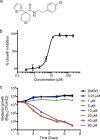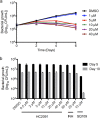HC2091 Kills Mycobacterium tuberculosis by Targeting the MmpL3 Mycolic Acid Transporter
- PMID: 29661875
- PMCID: PMC6021632
- DOI: 10.1128/AAC.02459-17
HC2091 Kills Mycobacterium tuberculosis by Targeting the MmpL3 Mycolic Acid Transporter
Abstract
Tuberculosis, caused by the intracellular pathogen Mycobacterium tuberculosis, is a deadly disease that requires a long course of treatment. The emergence of drug-resistant strains has driven efforts to discover new small molecules that can kill the bacterium. Here, we report characterizations of the compound HC2091, which kills M. tuberculosis in a time- and dose-dependent manner in vitro and inhibits M. tuberculosis growth in macrophages. Whole-genome sequencing of spontaneous HC2091-resistant mutants identified single-nucleotide variants in the mmpL3 mycolic acid transporter gene. HC2091-resistant mutants do not exhibit cross-resistance with the well-characterized Mycobacterium membrane protein large 3 (MmpL3) inhibitor SQ109, suggesting a distinct mechanism of interaction with MmpL3. Additionally, HC2091 does not modulate bacterial membrane potential or kill nonreplicating M. tuberculosis, thus acting differently from other known MmpL3 inhibitors. RNA sequencing (RNA-seq) transcriptional profiling and lipid profiling of M. tuberculosis treated with HC2091 or SQ109 show that the two compounds target a similar pathway. HC2091 has a chemical structure dissimilar to those of previously described MmpL3 inhibitors, supporting the notion that HC2091 is a new class of MmpL3 inhibitor.
Keywords: MmpL3; Mycobacterium tuberculosis; cell envelope; drug discovery; high-throughput screen; resistant mutants.
Copyright © 2018 American Society for Microbiology.
Figures




Similar articles
-
Identification of New MmpL3 Inhibitors by Untargeted and Targeted Mutant Screens Defines MmpL3 Domains with Differential Resistance.Antimicrob Agents Chemother. 2019 Sep 23;63(10):e00547-19. doi: 10.1128/AAC.00547-19. Print 2019 Oct. Antimicrob Agents Chemother. 2019. PMID: 31405862 Free PMC article.
-
Therapeutic Potential of the Mycobacterium tuberculosis Mycolic Acid Transporter, MmpL3.Antimicrob Agents Chemother. 2016 Aug 22;60(9):5198-207. doi: 10.1128/AAC.00826-16. Print 2016 Sep. Antimicrob Agents Chemother. 2016. PMID: 27297488 Free PMC article.
-
1H-Benzo[d]Imidazole Derivatives Affect MmpL3 in Mycobacterium tuberculosis.Antimicrob Agents Chemother. 2019 Sep 23;63(10):e00441-19. doi: 10.1128/AAC.00441-19. Print 2019 Oct. Antimicrob Agents Chemother. 2019. PMID: 31332069 Free PMC article.
-
MmpL3 inhibitors as antituberculosis drugs.Eur J Med Chem. 2020 Aug 15;200:112390. doi: 10.1016/j.ejmech.2020.112390. Epub 2020 May 4. Eur J Med Chem. 2020. PMID: 32447196 Review.
-
MmpL3 Inhibitors: Diverse Chemical Scaffolds Inhibit the Same Target.Mini Rev Med Chem. 2016;16(16):1274-1283. doi: 10.2174/1389557516666160118105319. Mini Rev Med Chem. 2016. PMID: 26776226 Review.
Cited by
-
Molecular Mechanisms of MmpL3 Function and Inhibition.Microb Drug Resist. 2023 May;29(5):190-212. doi: 10.1089/mdr.2021.0424. Epub 2023 Feb 21. Microb Drug Resist. 2023. PMID: 36809064 Free PMC article. Review.
-
A piperidinol-containing molecule is active against Mycobacterium tuberculosis by inhibiting the mycolic acid flippase activity of MmpL3.J Biol Chem. 2019 Nov 15;294(46):17512-17523. doi: 10.1074/jbc.RA119.010135. Epub 2019 Sep 27. J Biol Chem. 2019. PMID: 31562241 Free PMC article.
-
Cryo-EM structure and resistance landscape of M. tuberculosis MmpL3: An emergent therapeutic target.Structure. 2021 Oct 7;29(10):1182-1191.e4. doi: 10.1016/j.str.2021.06.013. Epub 2021 Jul 8. Structure. 2021. PMID: 34242558 Free PMC article.
-
Two-Way Regulation of MmpL3 Expression Identifies and Validates Inhibitors of MmpL3 Function in Mycobacterium tuberculosis.ACS Infect Dis. 2021 Jan 8;7(1):141-152. doi: 10.1021/acsinfecdis.0c00675. Epub 2020 Dec 15. ACS Infect Dis. 2021. PMID: 33319550 Free PMC article.
-
Structural and Functional Diversity of Resistance-Nodulation-Cell Division Transporters.Chem Rev. 2021 May 12;121(9):5378-5416. doi: 10.1021/acs.chemrev.0c00621. Epub 2020 Nov 19. Chem Rev. 2021. PMID: 33211490 Free PMC article. Review.
References
-
- Belardinelli JM, Yazidi A, Yang L, Fabre L, Li W, Jacques B, Angala SK, Rouiller I, Zgurskaya HI, Sygusch J, Jackson M. 2016. Structure-function profile of MmpL3, the essential mycolic acid transporter from Mycobacterium tuberculosis. ACS Infect Dis 2:702–713. doi:10.1021/acsinfecdis.6b00095. - DOI - PMC - PubMed
-
- Tahlan K, Wilson R, Kastrinsky DB, Arora K, Nair V, Fischer E, Barnes SW, Walker JR, Alland D, Barry CE III, Boshoff HI. 2012. SQ109 targets MmpL3, a membrane transporter of trehalose monomycolate involved in mycolic acid donation to the cell wall core of Mycobacterium tuberculosis. Antimicrob Agents Chemother 56:1797–1809. doi:10.1128/AAC.05708-11. - DOI - PMC - PubMed
Publication types
MeSH terms
Substances
Grants and funding
LinkOut - more resources
Full Text Sources
Other Literature Sources
Molecular Biology Databases

